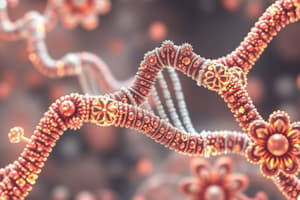Podcast
Questions and Answers
What is the initial step in the PCR process?
What is the initial step in the PCR process?
- Addition of nucleotides onto the ends of the annealed primers
- Separation of the two strands of the DNA molecule (correct)
- Raising the temperature at the end of a cycle
- Annealing of primers to the DNA template
What is the purpose of raising the temperature to about 72 °C in PCR?
What is the purpose of raising the temperature to about 72 °C in PCR?
- To allow annealing of primers to the DNA template
- To begin adding nucleotides onto the ends of the annealed primers (correct)
- To separate the two strands of the DNA molecule
- To reduce the temperature for the primers to anneal to the template
How does the number of DNA copies change after each cycle in PCR?
How does the number of DNA copies change after each cycle in PCR?
- It doubles after each cycle (correct)
- It decreases after each cycle
- It triples after each cycle
- It remains constant after each cycle
What is the temperature at which primers anneal to the DNA template in PCR?
What is the temperature at which primers anneal to the DNA template in PCR?
Flashcards are hidden until you start studying
Study Notes
PCR Process
- The initial step in the PCR process is denaturation, where the double-stranded DNA is separated into single strands.
PCR Temperature
- Raising the temperature to about 72 °C in PCR allows the enzyme Taq polymerase to synthesize new DNA strands by adding nucleotides to the primers.
DNA Copies
- After each cycle in PCR, the number of DNA copies doubles, resulting in an exponential increase in the amount of DNA.
Primer Annealing
- Primers anneal to the DNA template in PCR at a temperature of around 50-65 °C, which is specific to the primer sequence and allows for specific binding to the target DNA region.
Studying That Suits You
Use AI to generate personalized quizzes and flashcards to suit your learning preferences.




